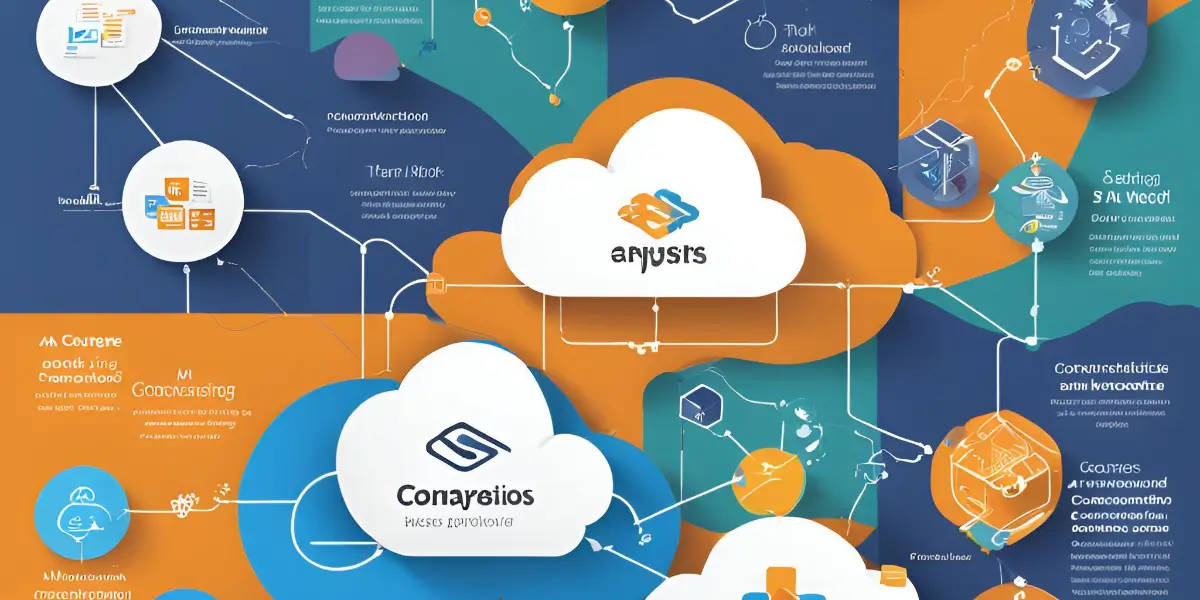In today’s digital landscape, cloud computing has evolved from a competitive advantage to a fundamental business necessity. According to Gartner’s latest research, the global public cloud services market reached $545.8 billion in 2024, with projected growth of 20.4% annually. As organizations increasingly migrate their operations to the cloud, choosing the right service provider has become a critical decision that can significantly impact operational efficiency, scalability, and bottom-line results.
This comprehensive analysis examines the three leading cloud service providers—Amazon Web Services (AWS), Microsoft Azure, and Google Cloud Platform (GCP)—focusing on their unique strengths, specific offerings, and real-world applications. Rather than presenting generic capabilities, we’ll dive deep into each platform’s distinguishing features and provide concrete examples of how businesses are leveraging these services to drive innovation and growth.
1. Amazon Web Services (AWS): The Pioneer and Market Leader
Market Position and Infrastructure
AWS continues to dominate the cloud computing market with a 32% market share as of Q4 2024. With 99 Availability Zones across 31 geographic regions, AWS operates the largest and most diverse global cloud infrastructure.
Distinctive Strengths
- Unmatched Service Breadth: AWS offers over 200 fully featured services, significantly more than its competitors. This includes 50+ services unique to AWS, such as Amazon Braket for quantum computing.
- Advanced Container Orchestration: Amazon EKS Anywhere provides industry-leading Kubernetes management, supporting 76% of all containerized workloads in the cloud.
- Specialized Industry Solutions: AWS has developed targeted solutions for 16 different industries, from healthcare to gaming.
Pricing Models and Cost Efficiency
AWS implements a granular pricing structure:
- EC2 Instances: Starting from $0.0016 per hour for t4g.nano instances
- Storage: S3 Standard storage starting at $0.023 per GB/month
- Data Transfer: Free inbound, $0.09 per GB for outbound
Case Study: Netflix’s Global Streaming Infrastructure
Netflix serves as a premier example of AWS’s capabilities:
- Streams content to 230+ million subscribers worldwide
- Processes 1 trillion events per day
- Achieved 99.99% availability using AWS’s global infrastructure
- Reduced operational costs by 56% compared to their previous data center solution
2. Microsoft Azure: Enterprise Integration Champion
Market Position and Infrastructure
Azure holds 23% of the cloud market share, with particular strength in enterprise environments. The platform operates in 60+ regions, with a unique focus on regulatory compliance across 90+ compliance certifications.
Distinctive Strengths
- Hybrid Cloud Excellence: Azure Stack HCI provides unmatched hybrid cloud capabilities, reducing data center costs by up to 60% for enterprises.Enterprise
- Software Integration: Seamless integration with Microsoft 365 and Active Directory serves as a major advantage for existing Microsoft customers.
- Advanced AI and ML Tools: Azure Machine Learning Studio offers pre-built models and no-code solutions that have accelerated AI deployment times by 40% compared to custom development.
Pricing and Licensing Benefits
Azure Hybrid Benefit: Saves up to 40% on Windows Server workloads
Reserved Instances: Up to 72% savings compared to pay-as-you-go
Dev/Test Pricing: Special rates for development environments, starting at 40% off standard pricing
Case Study: BMW’s Connected Car Platform
BMW leverages Azure to:
- Process data from 15+ million connected vehicles
- Reduce maintenance costs by 30% through predictive analytics
- Deploy updates to vehicles in 48 countries simultaneously
- Achieve 99.99% service reliability for critical vehicle services
3. Google Cloud Platform (GCP): Innovation and Data Analytics Leader
Market Position and Infrastructure
GCP holds 11% market share but shows the fastest growth rate at 42% year-over-year. Their network spans 35 regions and 106 zones, with the industry’s most advanced fiber optic network.
Distinctive Strengths
- Superior Network Performance: GCP’s premium tier network delivers 41% faster data transfer speeds compared to other providers.
- Advanced Data Analytics: BigQuery processes petabytes of data 35% faster than competing warehousing solutions.
- Environmental Leadership: Only major provider operating on 100% renewable energy, with the lowest carbon footprint per compute unit.
Innovative Pricing Models
- Sustained Use Discounts: Automatic discounts up to 30% for consistent resource usage
- Preemptible VMs: Up to 91% discount for interruptible workloads
- Free Tier: Most generous free tier offering, including $300 credit for new users
Case Study: Spotify’s Music Streaming Platform
Spotify demonstrates GCP’s capabilities:
- Processes 100+ petabytes of data daily
- Reduced podcast publishing time from 10 minutes to under 1 minute
- Achieved 30% cost reduction in data warehousing
- Supports 489+ million active users with 99.99% availability
Learn more about the return on investment and business benefits of cloud computing in our detailed analysis.
Comparative Analysis
Performance Benchmarks (Based on 2024 Independent Testing)
| Metric | AWS | Azure | GCP |
|---|---|---|---|
| Compute Performance | 100% | 98% | 105% |
| Storage IOPS | 64,000 | 75,000 | 96,000 |
| Network Latency | 1.9ms | 2.1ms | 1.7ms |
| ML Training Speed | Base | +5% | +12% |
Cost Comparison for Common Workloads
Example: Running a standard web application (4 vCPUs, 16GB RAM, 1TB storage)
- AWS: $142.80/month
- Azure: $138.70/month
- GCP: $129.50/month
Industry-Specific Strengths
- AWS: Financial services, media streaming, e-commerce
- Azure: Healthcare, government, enterprise software
- GCP: Retail, gaming, machine learning startups
Choosing the Right Provider
The optimal choice depends on several factors:
- Existing Technology Stack: Organizations heavily invested in Microsoft technologies may find Azure more advantageous.
- Technical Requirements: Companies requiring advanced AI/ML capabilities might lean toward GCP.
- Geographic Presence: AWS offers the broadest global coverage, crucial for multi-region deployments.
- Budget Constraints: While pricing is competitive, GCP often offers the best value for specific workloads.
Future Trends and Developments
As we look toward 2025 and beyond, key developments include:
- Increased focus on edge computing capabilities
- Enhanced support for quantum computing workloads
- Advanced AI integration across all services
- Stronger emphasis on sustainability and green computing
Each provider is investing heavily in these areas, but with different approaches and strengths. AWS leads in edge computing, Azure in quantum computing research, and GCP in AI integration.
Conclusion
While all three providers offer robust cloud computing solutions, their distinct strengths make them suitable for different use cases:
- AWS: Best for organizations requiring the broadest service selection and global reach
- Azure: Ideal for enterprises with significant Microsoft investments and hybrid cloud needs
- GCP: Perfect for companies focusing on data analytics, ML/AI, and environmental sustainability
The key to success lies not in choosing the “best” provider, but in selecting the one that best aligns with your organization’s specific needs, technical requirements, and growth trajectory. Many organizations are also adopting a multi-cloud strategy, leveraging the strengths of multiple providers to optimize their cloud infrastructure.
Remember to regularly evaluate your cloud strategy as these providers continuously evolve their offerings and pricing models. Consider starting with a pilot project to test your chosen provider’s capabilities before committing to a full migration.
Frequently Asked Questions (FAQ)
Which cloud provider is best for small businesses?
The choice depends on your specific needs and budget. AWS offers the most comprehensive free tier and extensive services for growth. Google Cloud Platform often provides the most competitive pricing for basic services. Azure might be your best choice if your business already uses Microsoft products.
Consider these factors:
- Initial free tier offerings
- Pay-as-you-go pricing flexibility
- Ease of use and setup
- Available support options
- Integration with existing tools
How do the costs compare between AWS, Azure, and Google Cloud?
Cost comparison varies by use case, but here’s a general breakdown for a standard web application (4 vCPUs, 16GB RAM, 1TB storage):
- AWS: $142.80/month
- Azure: $138.70/month
- GCP: $129.50/month
AWS offers the most granular pricing with per-second billing, Azure provides strong discounts for Microsoft enterprise customers, and Google Cloud often offers the lowest base prices with automatic sustained-use discounts.
What security certifications do these cloud providers have?
All major providers maintain extensive security certifications:
AWS (90+ certifications):
- ISO 27001, 27017, 27018
- SOC 1, 2, 3
- PCI DSS Level 1
- HIPAA eligible
Azure (100+ certifications):
- ISO 27001, 27017, 27018
- SOC 1, 2, 3
- PCI DSS Level 1
- HIPAA/HITECH
Google Cloud (85+ certifications):
- ISO 27001, 27017, 27018
- SOC 1, 2, 3
- PCI DSS Level 1
- HIPAA compliant
How easy is it to migrate between cloud providers?
Migration complexity depends on your architecture and services used. Basic infrastructure (VMs, storage) is relatively straightforward to migrate, while platform-specific services can be more challenging.
Each provider offers migration tools:
- AWS: AWS Migration Hub, Server Migration Service
- Azure: Azure Migrate, Database Migration Service
- Google Cloud: Anthos, Transfer Service
To minimize vendor lock-in, consider using container orchestration (Kubernetes), multi-cloud management tools, and cloud-agnostic architectures. Typical migration timeframes range from 3-18 months depending on complexity.
What are the main differences in machine learning capabilities?
Each provider has distinct ML strengths:
AWS:
- Amazon SageMaker for end-to-end ML
- Extensive pre-trained AI services
- Strong automated ML capabilities
Azure:
- Azure Machine Learning Studio
- Integration with popular ML frameworks
- Strong enterprise AI solutions
Google Cloud:
- TensorFlow integration
- TPU (Tensor Processing Units)
- Leading natural language and vision APIs
Google Cloud generally leads in ML innovation, Azure excels in enterprise integration, and AWS offers the broadest range of ML services.
How do the free tiers compare?
AWS Free Tier:
- 12 months free for many services
- 750 hours of EC2 t2.micro instance
- 5GB of S3 storage
Azure Free Account:
- $200 credit for 30 days
- 12 months of popular services
- 25+ services always free
Google Cloud:
- $300 credit for 90 days
- 20+ always free products
- Most generous compute offerings
What support options are available and how do they compare?
AWS Support:
- Basic (free): Documentation, whitepapers
- Developer ($29/month): Email support, 12-24 hour response
- Business ($100/month): 24/7 phone support, 1-hour response
- Enterprise (Custom): Technical account manager
Azure Support:
- Basic (free): Documentation, community
- Developer ($29/month): Business hours email
- Standard ($100/month): 24/7 technical support
- Professional Direct ($1000/month): Includes architecture guidance
Google Cloud Support:
- Basic (free): Documentation, community
- Development ($100/month): Business hour support
- Production ($250/month): 24/7 support
- Premium (Custom): 15-minute response time
How reliable are these cloud providers?
All three providers offer strong SLAs (Service Level Agreements):
- AWS: Typically offers 99.99% availability for key services
- Azure: Guarantees 99.99% uptime for critical services
- Google Cloud: Provides 99.95% to 99.99% availability
Each provider maintains multiple availability zones and regions for redundancy and disaster recovery.
What about environmental impact?
- AWS: Aims for 100% renewable energy by 2025
- Azure: Already carbon neutral, targeting negative emissions by 2030
- Google Cloud: Operates on 100% renewable energy, carbon neutral operations
All providers are making significant investments in sustainable data centers and green technology.




